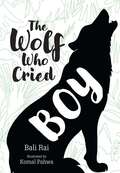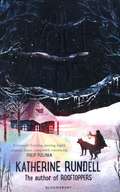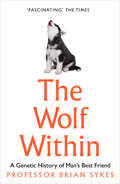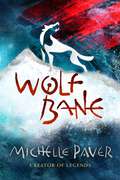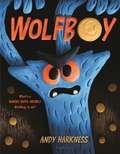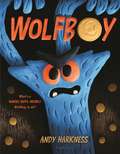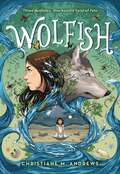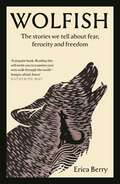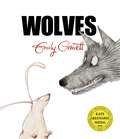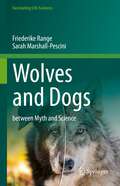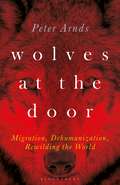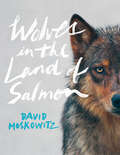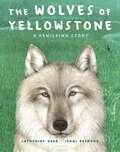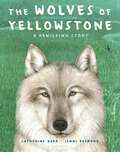- Table View
- List View
The Wolf Wilder
by Katherine RundellGo on an adventure with Katherine Rundell …From the winner of the Costa Children's Book Prize'A writer with an utterly distinctive voice and a wild imagination' – Philip PullmanFeodora and her mother live in the snowbound woods of Russia, in a house full of food and fireplaces. Ten minutes away, in a ruined chapel, lives a pack of wolves. Feodora's mother is a wolf wilder, and Feo is a wolf wilder in training. A wolf wilder is the opposite of an animal tamer: it is a person who teaches tamed animals to fend for themselves, and to fight and to run, and to be wary of humans.When the murderous hostility of the Russian Army threatens her very existence, Feo is left with no option but to go on the run. What follows is a story of revolution and adventure, about standing up for the things you love and fighting back. And, of course, wolves.
The Wolf Wilder (PDF)
by Katherine Rundell Gelrev OngbicoFeodora and her mother live in the snowbound woods of Russia, in a house full of food and fireplaces. Ten minutes away, in a ruined chapel, lives a pack of wolves. Feodora's mother is a wolf wilder, and Feo is a wolf wilder in training. A wolf wilder is the opposite of an animal tamer: it is a person who teaches tamed animals to fend for themselves, and to fight and to run, and to be wary of humans. When the murderous hostility of the Russian Army threatens her very existence, Feo is left with no option but to go on the run. What follows is a story of revolution and adventure, about standing up for the things you love and fighting back. And, of course, wolves.
The Wolf Within: A Genetic History Of Man's Best Friend
by Professor Bryan SykesThe genetic history of the dog is a sensational example of the co-evolution of two species, man and wolf, to each other’s mutual benefit. But how did this ancient partnership begin? To answer this question, Professor Bryan Sykes identifies tantalising clues in the recently mapped genetic makeup of both species.
Wolfbane (Wolf Brother #9)
by Michelle PaverGrand finale to the prize-winning adventure series that's changed the lives of millions of readers. Breathtaking world-building on an epic scale. Pure escapism at its best. It is early spring, a turbulent, perilous time of sudden storms, frozen river fractures and drifting ice. Fleeing from a demon intent on devouring his souls, Wolf is swept out to Sea far from the Forest and his pack. The ocean too teems with danger: sea wolves, sharks and hunters of the deep, and the demon is gaining ground. Torak and Renn must race to save their pack-brother, battling the harsh, icy waves and merciless torrents. If they can't find Wolf in time, the bond between them will be severed for ever...Run wild with Wolf Brother for the last time in a Stone Age world we all want to be part of, with three-million-copy-selling author Michelle Paver, Creator of Legends.Read WOLFBANE as a standalone adventure or as part of the well-loved series.'Can easily be read as a standalone novel, so skilful is the storytelling... Paver powerfully presents a world view that's magical but never primitive' Financial Times on Skin Taker'Meticulously researched, atmospheric [...] and relentless... Introduces Paver to a new generation of readers' Guardian on Viper's Daughter
Wolfboy
by Andy HarknessPerfect for fans of Grumpy Monkey and The Bad Seed, this dynamic and hilarious picture book from an exciting new talent shows how feeling hangry can turn even the sweetest kid into a snarling, growling Wolfboy!Wolfboy is hungry! He's drooly and growly and fussy!As he stomps through the forest looking for rabbits, he grows hungrier and growlier by the minute. What will happen if Wolfboy can't find those rabbits? And what will happen if he does?With bold illustrations and energetic storytelling, Wolfboy perfectly captures the big feelings that come with being very hungry! Engaging for young readers and parents, this funny and fresh picture book will be an instant favorite for all families.
Wolfboy
by Andy HarknessPerfect for fans of Grumpy Monkey and The Bad Seed, this dynamic and hilarious picture book from an exciting new talent shows how feeling hangry can turn even the sweetest kid into a snarling, growling Wolfboy!Wolfboy is hungry! He's drooly and growly and fussy!As he stomps through the forest looking for rabbits, he grows hungrier and growlier by the minute. What will happen if Wolfboy can't find those rabbits? And what will happen if he does?With bold illustrations and energetic storytelling, Wolfboy perfectly captures the big feelings that come with being very hungry! Engaging for young readers and parents, this funny and fresh picture book will be an instant favorite for all families.
Wolfboy
by Andy HarknessWolfboy is hungry! He's drooly and growly and fussy!As he stomps through the forest looking for rabbits, he grows hungrier and growlier by the minute! What will happen if Wolfboy can't find those rabbits? And what will happen if he does?With bold illustrations and energetic storytelling, Wolfboy perfectly captures the big feelings that come with being very hungry! Engaging, original and perfect for reading aloud, this funny and fresh picture book is a must-have for anyone who's ever been impatient for their food.
Wolfie's Secret
by Nicola SeniorWolfie was no ordinary wolf. He was a wolf with a difference. He had a special, super secret that nobody knew . . .Wolfie is supposed to be a big bad wolf. Unfortunately though, he's not very good at it - and worse yet, he has a terrible secret. Instead of gobbling up little pigs, Wolfie would much rather be wolfing down . . . cakes! Yes, it's true - this big, burly wolf is a star baker in the making. But can he keep his secret from that pesky Little Red?This stunning debut from author/illustrator Nicola Senior is a playful take on an old favourite tale, and one sure to make you laugh as you root for a wonderful new hero.
Wolfish
by Christiane M. AndrewsThe Inquisitor&’s Tale meets The Book of Boy in this adventurous fantasy inspired by the myth of Romulus and Remus.Twelve-year-old Rae is content as the adopted daughter of shepherds, helping with the flock and reveling in the beauty of her family&’s hillside farm. But after a frightening encounter with a wolf—to whom she feels a sudden, peculiar connection—Rae realizes there is much more to her past, and her future, than she could have imagined.Meanwhile, a young girl named Alba goes about her days as an oracle&’s apprentice, a duty that confines her to a distant, watery cave. But when she bestows a troubling prophecy on the rising boy-king, her words unintentionally begin a reign of terror, and send Alba on a desperate mission alongside Rae and the wolf.Inspired by Roman mythology, this mysterious and uniquely magical adventure explores the intricate roles of nature and fate in our lives, the power of language to shape our world, and the boundless importance of love and kindness.
Wolfish
by Christiane M. AndrewsFor fans of Kelly Barnhill, Wolfish is an expansive, adventurous fantasy unlike anything you've ever read, inspired by the myth of twin boys Romulus and Remus. Shortlisted for the Ursula K. Le Guin Prize for Fiction! Twelve-year-old Rae is content as the adopted daughter of shepherds, helping with the flock and reveling in the beauty of her family&’s hillside farm. But after a frightening encounter with a wolf—to whom she feels a sudden, peculiar connection—Rae realizes there is much more to her past, and her future, than she could have imagined. Meanwhile, a young girl named Alba goes about her days as an oracle&’s apprentice, a duty that confines her to a distant, watery cave. But when she bestows a troubling prophecy on the rising boy-king, her words unintentionally begin a reign of terror, and send Alba on a desperate mission alongside Rae and the wolf. Inspired by Roman mythology, this mysterious and uniquely magical adventure explores the intricate roles of nature and fate in our lives, the power of language to shape our world, and the boundless importance of love and kindness.
Wolfish: The stories we tell about fear, ferocity and freedom
by Erica BerryA MOST ANTICIPATED BOOK OF 2023 FOR FINANCIAL TIMES, TIME, VULTURE, LIT HUB, GOODREADS, RUMPUS, BUSTLE, READER'S DIGEST and more Both vilified and venerated, wolves abound through cultural folklore and literature. In this hauntingly lyrical and unflinching inquiry, Erica Berry untangles these depictions - alongside her own research of the wolf and experience as a woman - to try to understand how we navigate terror, vulnerability and violence in our fragile, often dangerous world. Luminously wise and unusually brave, Wolfish will stay with you long into the night.
Wolves: Behavior, Ecology, and Conservation
by Luigi Boitani L. David MechWolves are some of the world's most charismatic and controversial animals, capturing the imaginations of their friends and foes alike. Highly intelligent and adaptable, they hunt and play together in close-knit packs, sometimes roaming over hundreds of square miles in search of food. Once teetering on the brink of extinction across much of the United States and Europe, wolves have made a tremendous comeback in recent years, thanks to legal protection, changing human attitudes, and efforts to reintroduce them to suitable habitats in North America. As wolf populations have rebounded, scientific studies of them have also flourished. But there hasn't been a systematic, comprehensive overview of wolf biology since 1970. In Wolves, many of the world's leading wolf experts provide state-of-the-art coverage of just about everything you could want to know about these fascinating creatures. Individual chapters cover wolf social ecology, behavior, communication, feeding habits and hunting techniques, population dynamics, physiology and pathology, molecular genetics, evolution and taxonomy, interactions with nonhuman animals such as bears and coyotes, reintroduction, interactions with humans, and conservation and recovery efforts. The book discusses both gray and red wolves in detail and includes information about wolves around the world, from the United States and Canada to Italy, Romania, Saudi Arabia, Israel, India, and Mongolia. Wolves is also extensively illustrated with black and white photos, line drawings, maps, and fifty color plates. Unrivalled in scope and comprehensiveness, Wolves will become the definitive resource on these extraordinary animals for scientists and amateurs alike. “An excellent compilation of current knowledge, with contributions from all the main players in wolf research. . . . It is designed for a wide readership, and certainly the language and style will appeal to both scientists and lucophiles alike. . . . This is an excellent summary of current knowledge and will remain the standard reference work for a long time to come.”—Stephen Harris, New Scientist “This is the place to find almost any fact you want about wolves.”—Stephen Mills, BBC Wildlife Magazine
Wolves
by Emily GravettRabbit borrows a book about wolves from the library. He can't put it down! But soon a sinister figure with sharp claws and a bushy tail starts to creep right off the pages. You won't believe your eyes – but if you're a rabbit, you probably should.Brilliantly witty, ingeniously constructed, and with amazing artwork throughout, Wolves has thrilled critics and booksellers alike. Wolves was Emily Gravett's debut book, winning her the Macmillan Prize for Illustration and her first CILIP Kate Greenaway Award.
Wolves: Behavior, Ecology, and Conservation
by L. David Mech Luigi BoitaniWolves are some of the world's most charismatic and controversial animals, capturing the imaginations of their friends and foes alike. Highly intelligent and adaptable, they hunt and play together in close-knit packs, sometimes roaming over hundreds of square miles in search of food. Once teetering on the brink of extinction across much of the United States and Europe, wolves have made a tremendous comeback in recent years, thanks to legal protection, changing human attitudes, and efforts to reintroduce them to suitable habitats in North America. As wolf populations have rebounded, scientific studies of them have also flourished. But there hasn't been a systematic, comprehensive overview of wolf biology since 1970. In Wolves, many of the world's leading wolf experts provide state-of-the-art coverage of just about everything you could want to know about these fascinating creatures. Individual chapters cover wolf social ecology, behavior, communication, feeding habits and hunting techniques, population dynamics, physiology and pathology, molecular genetics, evolution and taxonomy, interactions with nonhuman animals such as bears and coyotes, reintroduction, interactions with humans, and conservation and recovery efforts. The book discusses both gray and red wolves in detail and includes information about wolves around the world, from the United States and Canada to Italy, Romania, Saudi Arabia, Israel, India, and Mongolia. Wolves is also extensively illustrated with black and white photos, line drawings, maps, and fifty color plates. Unrivalled in scope and comprehensiveness, Wolves will become the definitive resource on these extraordinary animals for scientists and amateurs alike. “An excellent compilation of current knowledge, with contributions from all the main players in wolf research. . . . It is designed for a wide readership, and certainly the language and style will appeal to both scientists and lucophiles alike. . . . This is an excellent summary of current knowledge and will remain the standard reference work for a long time to come.”—Stephen Harris, New Scientist “This is the place to find almost any fact you want about wolves.”—Stephen Mills, BBC Wildlife Magazine
Wolves: Behavior, Ecology, and Conservation
by L. David Mech Luigi BoitaniWolves are some of the world's most charismatic and controversial animals, capturing the imaginations of their friends and foes alike. Highly intelligent and adaptable, they hunt and play together in close-knit packs, sometimes roaming over hundreds of square miles in search of food. Once teetering on the brink of extinction across much of the United States and Europe, wolves have made a tremendous comeback in recent years, thanks to legal protection, changing human attitudes, and efforts to reintroduce them to suitable habitats in North America. As wolf populations have rebounded, scientific studies of them have also flourished. But there hasn't been a systematic, comprehensive overview of wolf biology since 1970. In Wolves, many of the world's leading wolf experts provide state-of-the-art coverage of just about everything you could want to know about these fascinating creatures. Individual chapters cover wolf social ecology, behavior, communication, feeding habits and hunting techniques, population dynamics, physiology and pathology, molecular genetics, evolution and taxonomy, interactions with nonhuman animals such as bears and coyotes, reintroduction, interactions with humans, and conservation and recovery efforts. The book discusses both gray and red wolves in detail and includes information about wolves around the world, from the United States and Canada to Italy, Romania, Saudi Arabia, Israel, India, and Mongolia. Wolves is also extensively illustrated with black and white photos, line drawings, maps, and fifty color plates. Unrivalled in scope and comprehensiveness, Wolves will become the definitive resource on these extraordinary animals for scientists and amateurs alike. “An excellent compilation of current knowledge, with contributions from all the main players in wolf research. . . . It is designed for a wide readership, and certainly the language and style will appeal to both scientists and lucophiles alike. . . . This is an excellent summary of current knowledge and will remain the standard reference work for a long time to come.”—Stephen Harris, New Scientist “This is the place to find almost any fact you want about wolves.”—Stephen Mills, BBC Wildlife Magazine
Wolves and Dogs: between Myth and Science (Fascinating Life Sciences)
by Friederike Range Sarah Marshall-PesciniVarious parallels have been drawn between wolves and humans from the perspective of their social organisation. Therefore, studying wolves may well shed light on the evolutionary origins of complex human cognition and, in particular, on the role that cooperation played in its development. Humans closely share their lives with millions of dogs – the domesticated form of wolves. Biologically, wolves and dogs can be considered to be the same species; yet only dogs are suitable living companions in human homes, highlighting the importance of cognitive and emotional differences between the two forms. The behaviour of wolves and dogs largely depends on the environment the animals grew up and live in. This book reviews more than 50 years of research on the differences and similarities of wolves and dogs. Beyond the socio-ecology, the work explores different theories about when and how the domestication of wolves might have started and which behaviours and cognitive abilities might have changed during this process. Readers will discover how these fascinating animals live with their conspecifics in their social groups, how they approach and solve problems in their daily lives and how they see and interact with their human partners.
Wolves at the Door: Migration, Dehumanization, Rewilding the World
by Peter ArndsIn view of the current rhetoric surrounding the global migrant crisis – with politicians comparing refugees with animals and media reports warning of migrants swarming like insects or trespassing like wolves – this timely study explores the cultural origins of the language and imagery of dehumanization. Situated at the junction of literature, politics, and ecocriticism, Wolves at the Door traces the history of the wolf metaphor in discussions of race, gender, colonialism, fascism, and ecology. How have 'Gypsies', Jews, Native Americans but also 'wayward' women been 'wolfed' in literature and politics? How has the wolf myth been exploited by Hitler, Mussolini and Turkish ultra-nationalism? How do right-wing politicians today exploit the reappearance of wolves in Central Europe in the context of the migration discourse? And while their reintroduction in places like Yellowstone has fuelled heated debates, what is the wolf's role in ecological rewilding and for the restoration of biodiversity? In today's fraught political climate, Wolves at the Door alerts readers to the links between stereotypical images, their cultural history, and their political consequences. It raises awareness about xenophobia and the dangers of nationalist idolatry, but also highlights how literature and the visual arts employ the wolf myth for alternative messages of tolerance and cultural diversity.
Wolves at the Door: Migration, Dehumanization, Rewilding the World
by Peter ArndsIn view of the current rhetoric surrounding the global migrant crisis – with politicians comparing refugees with animals and media reports warning of migrants swarming like insects or trespassing like wolves – this timely study explores the cultural origins of the language and imagery of dehumanization. Situated at the junction of literature, politics, and ecocriticism, Wolves at the Door traces the history of the wolf metaphor in discussions of race, gender, colonialism, fascism, and ecology. How have 'Gypsies', Jews, Native Americans but also 'wayward' women been 'wolfed' in literature and politics? How has the wolf myth been exploited by Hitler, Mussolini and Turkish ultra-nationalism? How do right-wing politicians today exploit the reappearance of wolves in Central Europe in the context of the migration discourse? And while their reintroduction in places like Yellowstone has fuelled heated debates, what is the wolf's role in ecological rewilding and for the restoration of biodiversity? In today's fraught political climate, Wolves at the Door alerts readers to the links between stereotypical images, their cultural history, and their political consequences. It raises awareness about xenophobia and the dangers of nationalist idolatry, but also highlights how literature and the visual arts employ the wolf myth for alternative messages of tolerance and cultural diversity.
Wolves in the Land of Salmon
by David MoskowitzDave Moskowitz's remarkable story will resonate everywhere that mighty social animals—like humans and wolves—struggle to coexist. With its strong narrative thread, this ambitious chronicle is nature writing at its best—both timely analysis and wilderness adventure.
The Wolves of Yellowstone: A Rewilding Story
by Catherine BarrHere is the fascinating true story of the wolves who restored the ecosystem at Yellowstone National Park, written by Catherine Barr and illustrated by award-winner Jenni Desmond.In the 1930s, the last wolves disappeared from Yellowstone National Park. Without them, elk herds overran the plains. Bears starved, rabbit families shrunk, and birds flew away to new homes. Then plants and trees started to die off, too-even the flow of rivers was affected. Could the park be saved . . . by the wolves it had lost? After years of planning, in 1995 a team of experts was ready to find out. They carefully relocated fourteen wolves from the Canadian Rockies to Yellowstone. This is the story of their homecoming.Engaging, informative, and hopeful, The Wolves of Yellowstone shows us that every creature plays a role in sustaining a thriving ecosystem.
The Wolves of Yellowstone: A Rewilding Story
by Catherine BarrHere is the fascinating true story of the wolves who restored the ecosystem at Yellowstone National Park, written by Catherine Barr and illustrated by award-winner Jenni Desmond.In the 1930s, the last wolves disappeared from Yellowstone National Park. Without them, elk herds overran the plains. Bears starved, rabbit families shrunk, and birds flew away to new homes. Then plants and trees started to die off, too-even the flow of rivers was affected. Could the park be saved . . . by the wolves it had lost? After years of planning, in 1995 a team of experts was ready to find out. They carefully relocated fourteen wolves from the Canadian Rockies to Yellowstone. This is the story of their homecoming.Engaging, informative, and hopeful, The Wolves of Yellowstone shows us that every creature plays a role in sustaining a thriving ecosystem.
Wolves on the Hunt: The Behavior of Wolves Hunting Wild Prey
by L. David Mech Douglas W. Smith Daniel R. MacNultyThe interactions between apex predators and their prey are some of the most awesome and meaningful in nature—displays of strength, endurance, and a deep coevolutionary history. And there is perhaps no apex predator more impressive and important in its hunting—or more infamous, more misjudged—than the wolf. Because of wolves’ habitat, speed, and general success at evading humans, researchers have faced great obstacles in studying their natural hunting behaviors. The first book to focus explicitly on wolf hunting of wild prey, Wolves on the Hunt seeks to fill these gaps in our knowledge and understanding. Combining behavioral data, thousands of hours of original field observations, research in the literature, a wealth of illustrations, and—in the e-book edition and online—video segments from cinematographer Robert K. Landis, the authors create a compelling and complex picture of these hunters. The wolf is indeed an adept killer, able to take down prey much larger than itself. While adapted to hunt primarily hoofed animals, a wolf—or especially a pack of wolves—can kill individuals of just about any species. But even as wolves help drive the underlying rhythms of the ecosystems they inhabit, their evolutionary prowess comes at a cost: wolves spend one-third of their time hunting—the most time consuming of all wolf activities—and success at the hunt only comes through traveling long distances, persisting in the face of regular failure, detecting and taking advantage of deficiencies in the physical condition of individual prey, and through ceaseless trial and error, all while risking injury or death. By describing and analyzing the behaviors wolves use to hunt and kill various wild prey—including deer, moose, caribou, elk, Dall sheep, mountain goats, bison, musk oxen, arctic hares, beavers, and others—Wolves on the Hunt provides a revelatory portrait of one of nature’s greatest hunters.
Wolves on the Hunt: The Behavior of Wolves Hunting Wild Prey
by L. David Mech Douglas W. Smith Daniel R. MacNultyThe interactions between apex predators and their prey are some of the most awesome and meaningful in nature—displays of strength, endurance, and a deep coevolutionary history. And there is perhaps no apex predator more impressive and important in its hunting—or more infamous, more misjudged—than the wolf. Because of wolves’ habitat, speed, and general success at evading humans, researchers have faced great obstacles in studying their natural hunting behaviors. The first book to focus explicitly on wolf hunting of wild prey, Wolves on the Hunt seeks to fill these gaps in our knowledge and understanding. Combining behavioral data, thousands of hours of original field observations, research in the literature, a wealth of illustrations, and—in the e-book edition and online—video segments from cinematographer Robert K. Landis, the authors create a compelling and complex picture of these hunters. The wolf is indeed an adept killer, able to take down prey much larger than itself. While adapted to hunt primarily hoofed animals, a wolf—or especially a pack of wolves—can kill individuals of just about any species. But even as wolves help drive the underlying rhythms of the ecosystems they inhabit, their evolutionary prowess comes at a cost: wolves spend one-third of their time hunting—the most time consuming of all wolf activities—and success at the hunt only comes through traveling long distances, persisting in the face of regular failure, detecting and taking advantage of deficiencies in the physical condition of individual prey, and through ceaseless trial and error, all while risking injury or death. By describing and analyzing the behaviors wolves use to hunt and kill various wild prey—including deer, moose, caribou, elk, Dall sheep, mountain goats, bison, musk oxen, arctic hares, beavers, and others—Wolves on the Hunt provides a revelatory portrait of one of nature’s greatest hunters.
Wolves on the Hunt: The Behavior of Wolves Hunting Wild Prey
by L. David Mech Douglas W. Smith Daniel R. MacNultyThe interactions between apex predators and their prey are some of the most awesome and meaningful in nature—displays of strength, endurance, and a deep coevolutionary history. And there is perhaps no apex predator more impressive and important in its hunting—or more infamous, more misjudged—than the wolf. Because of wolves’ habitat, speed, and general success at evading humans, researchers have faced great obstacles in studying their natural hunting behaviors. The first book to focus explicitly on wolf hunting of wild prey, Wolves on the Hunt seeks to fill these gaps in our knowledge and understanding. Combining behavioral data, thousands of hours of original field observations, research in the literature, a wealth of illustrations, and—in the e-book edition and online—video segments from cinematographer Robert K. Landis, the authors create a compelling and complex picture of these hunters. The wolf is indeed an adept killer, able to take down prey much larger than itself. While adapted to hunt primarily hoofed animals, a wolf—or especially a pack of wolves—can kill individuals of just about any species. But even as wolves help drive the underlying rhythms of the ecosystems they inhabit, their evolutionary prowess comes at a cost: wolves spend one-third of their time hunting—the most time consuming of all wolf activities—and success at the hunt only comes through traveling long distances, persisting in the face of regular failure, detecting and taking advantage of deficiencies in the physical condition of individual prey, and through ceaseless trial and error, all while risking injury or death. By describing and analyzing the behaviors wolves use to hunt and kill various wild prey—including deer, moose, caribou, elk, Dall sheep, mountain goats, bison, musk oxen, arctic hares, beavers, and others—Wolves on the Hunt provides a revelatory portrait of one of nature’s greatest hunters.
